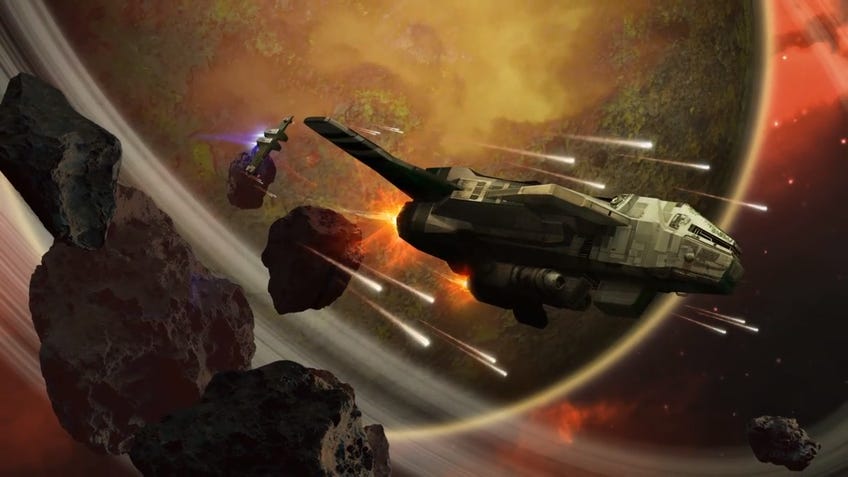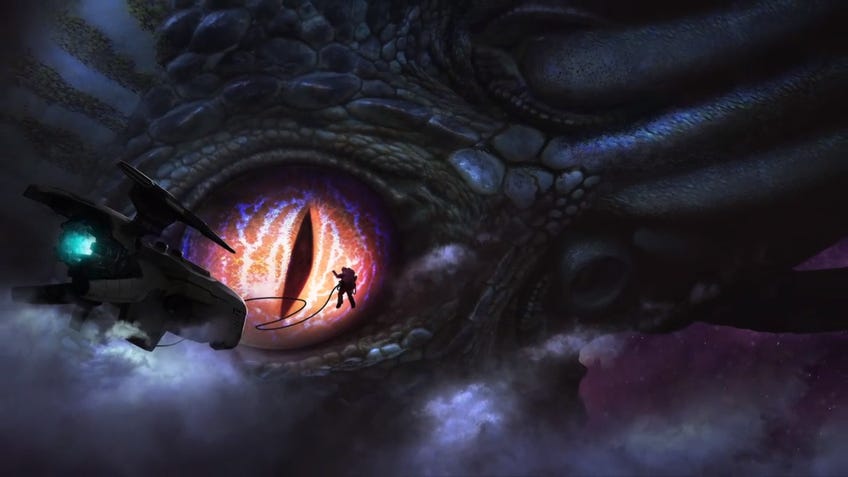Shawn Tomkin has reached the stars with Ironsworn: Starforged, but he couldn't do it alone
The designer talks influences, making a good thing even better and the importance of community feedback.
Designer Shawn Tomkin never really expected Ironsworn to achieve its current level of success and popularity. The touted low-fantasy tabletop game has found staunch fans among those who prefer to roll dice on their lonesome and has given its creator the ability to Kickstart a sci-fi follow-up called Ironsworn: Starforged.
“I really anticipated that I'd throw this thing [Ironsworn] out there as a free PDF, and it would generate a little bit of interest with a small number of people,” Tomkin told Dicebreaker in an interview. “I would have something I can play when I want to play a solo game or co-op with my wife, and that would be the end of it.”
The Kickstarter campaign for Starforged rocketed past its initial ask of $15,000 (£10,600) on the first day and currently rests just shy of $300,000 (£212,000) with less than three days remaining in the campaign. More than a sequel, Starforged is a synthesis of design lessons, community input and the financial freedom borne from the success of Ironsworn. For players both new and familiar, it’s looking like his best work yet.
Starforged had been knocking the back of Tomkin’s mind essentially since he first concepted its predecessor, Ironsworn. While he focused on the Greenland-adjacent setting of the Ironlands, with its displaced clans, old traditions and unforgiving wilderness, another part chewed on a universe more akin to Star Wars’ Outer Rim and the nearly lawless space frontier of shows like Firefly or the Expanse. The low-tech, human-centric stories with their focus on survival and exploration have always scratched an itch in Tomkin’s creativity, but his decision to focus on the Ironlands first was one of chance.
Both games work on the same mechanic foundation: a fiction-forward game where players narrate their character’s action until they come to a decision, inflection point or obstacle. Then, based on circumstances, they choose an appropriate move from a list and roll some dice. The outcome prompts further story, whether they succeed or fail - play always moves forward. Complicating all this are specifically chosen moves called Assets, the constant management of supplies and health while roughing it, and the fictional truths of each player’s world that they lay out before ever taking a step outside their home village.
There's going to be some lonely rocky planet, but some things will be a planet-sized Amoeba and everything in between.
And while both Ironsworn and Starforged can be guided by a GM, Tomkin designed them with solo or cooperative play as the primary focus. It’s the kind of tabletop experience he craved as a seemingly eternal GM and one that fits the demands of someone no longer able to spend eight hours every weekend around a table with friends. Plus, he simply enjoys this style of game.
“I always say that, as a game designer, if you're not making the thing that you want to play - that you feel like it doesn't exist in the form you want to play it - if you're not doing that thing, you're probably making the wrong game,” Tomkin said.
That moral guided him through the design of Starforged as it ballooned from a setting swap to a planned supplement to an entire project that consumed most of his free time in the past couple of years. Luckily, the continued success of Ironsworn allowed him to expand his team of one to include editors, sensitivity and disability consultants, and - critically important to Tomkin - artist Joshua Meehan. The shift was a necessary one to fully realize his vision of Starforged.
“It's a bit of a learning experience in terms of making sure that I'm trusting others and giving them authority and not controlling things too much,” he said. “Which is probably the inclination when you come from a one person project to opening it up to our broader team. But mostly, it's fantastic.”

An unofficial part of the team that Tomkin couldn’t praise highly enough was the community of players. Ironsworn began development during the bygone days of the Google+ tabletop RPG community, where he would release chunks at a time for playtesting and feedback. Ironsworn gradually took shape from the clay of Tomkin’s mind moulded by hundreds of interested players. Since release, he has continued the trend of considering the comments, praise and complaints from a fanbase he’s proud to say is inclusive, kind and eager to spread the good word of solo RPGs.
“I've been fortunate in that there's a lot online where I could watch people play the game. There's even a few podcasts that play the game. So that's hugely instructive as a designer,” Tomkin said. “It's almost like doing a live play test, but I can sit there and passively look at people and see how they interpret the mechanics - how they play the game - especially for these solo and co-op things.”
I would absolutely not be doing this if it weren't for such a positive, supportive community.
A big influence on the setting of Starforged, which takes place well beyond our galaxy and any planet we’ve even glimpsed in a telescope, was the video game No Man’s Sky. It’s procedurally generated universe provides an endless platform of stars, planets and lifeforms for missions and objective players can access using their personal starship. It is a game that prioritises the unknown on the galactic horizons and always presents new locations to visit.
“Some of those locations are going to be mundane. There's going to be some lonely rocky planet, but some things will be a planet-sized Amoeba and everything in between. So, just that idea of the mundane mixed with the occasional wondrous is really cool to depict in a tabletop game.”
Tomkin had a few important facets to address with Starforged that he felt would smooth the overall play experience. One was to overhaul the relationship system between the player character and the handful of NPCs they formed bonds with. In Ironsworn, these connections rewarded players once they were fulfilled but didn’t serve much of a purpose past that point.
Tomkin stressed that “people are stories” but found it difficult to encourage players not to indulge in the impulse of simply jetting off into the unknown and never encountering another living being. The solution to that problem arrived in untangling another: how to reimagine violence and combat in his sci-fi setting.
“Typically you're trying to get the data, you're trying to save the princess and fighting is somewhat of an ancillary sort of thing that's getting in the way of that,” he said. “So, turning fights from something that's focused on inflicting harm on your opponent to just moving towards an objective was a big part of that sort of subsystem in the game.”
In Starforged, conflict can just as easily be a laser blaster shootout as it is a tense negotiation with the colony’s mayor over drinks in an asteroid bar. It can mean returning to that contact that burned you and attempting to remain civil, or it can look like intimidating the raider leader into temporarily siding with you against the oncoming frigate of mercenaries.
If you're not making the thing that you want to play - that you feel like it doesn't exist in the form you want to play it - if you're not doing that thing, you're probably making the wrong game.
Fundamental to Starforged is an overhaul to the onboarding experience. One of the most common complaints with Ironsworn is how difficult it can be to bridge the gap between creating a character and letting them loose in its world. Tomkin took that criticism to heart and reformatted those sections of Starforged’s book to play out akin to a Session Zero exercise in a more conventional RPG campaign.
A player or group begins by establishing core Truths about their version of the Forge, the foster galaxy for a humanity on their run from apocalyptic upheaval. What does governance look like? How much technology survived the intergalactic flight? Are AI still around, and if so what do they look like? From there, players chart a tiny but personally significant sector that will serve as the launchpad for their adventures, providing an ecosystem of locations, mysteries and interesting people with their own motivations and problems. I’ve gone through the setup multiple times and it hits all the same high notes of a solid worldbuild game.
“My favorite thing right now is watching streams of people doing that campaign setup exercise because they’re just a ton of fun to watch,” Tomkin said. “Like how they interpret things for their settlements, what's going on there, what factions are involved and what problems they are dealing with all sort of tied to these Truths they set. That's magic for me. I could spend the rest of my days just watching people do that and be pretty happy.”

The Ironsworn: Starforged Kickstarter runs through May 26th. Those who back it will immediately gain access to a version of the book Tomkin calls “relatively feature complete”. He and the team will be using the rest of 2021 to finalize the design of the book and include all the stretch goals nearly $300,000 has unlocked. Throughout our conversation, Tomkin could not heap enough gratitude on his players.
“I would absolutely not be doing this if it weren't for such a positive, supportive community. It's a huge blessing as a creator to be sitting here having my Discord server ping off while in an interview with people chatting about Starforged,” he said. “I mean, that's just cool. That's a little bit surreal to me, still.”



